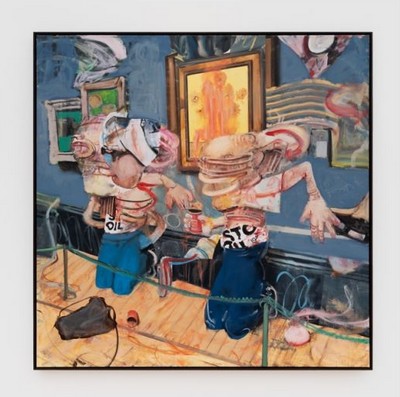Adrian Ghenie: The Brave New World
Pace Gallery, New York
November 10 – December 22, 2023
Untitled, 2023
© Adrian Ghenie, courtesy Pace Gallery
Pace presents The Brave New World, an exhibition of new paintings and works on paper by Adrian Ghenie, at its 510 West 25th Street gallery in New York. The works in the show examine the constantly evolving relationship between the human body and technology, meditating on the ways that digital devices and fugitive images have fundamentally altered our everyday existence and experience of the world. This presentation also poses questions about the uses of painting itself, exploring how the medium can articulate the effects of the radical technological advancements of the past 20 years.
Widely considered one of the most dynamic and versatile painters of his generation, Adrian Ghenie has reinvented his style time and again. Best known for lush renderings of figures in layered, cinematic compositions that mine visual, political, and social histories—in particular those of Central Europe and his native Romania—the artist has often examined the conditions of contemporary life by turning his focus to a particular genre, era, or subject in developing new bodies of work.
In the last several years, Adrian Ghenie’s works have meditated on the culture of disconnection and alienation in a technologically saturated world. He conjures the banality of the current moment through lusciously painted works in oil, as well as large-scale drawings in charcoal, which move seamlessly between abstraction and figuration. The figures in his works are often obsessively checking their cellphones, illuminated by the screens of their laptop computers, or caught in the gaze of a surveillance apparatus, their bodies dissolving and unraveling before the viewer’s eyes.
The works that Adrian Ghenie will show in his upcoming exhibition with Pace in New York include more than a dozen paintings and a suite of gestural drawings in which the artist develops many of the ideas and motifs in his canvases. In his new compositions, distorted and contorted figures clutch phones in their hands, pressing the devices to their faces or hunching over glowing screens. Adrian Ghenie’s images speak to the contradictions of these ubiquitous devices, which, despite their purported ability to foster interpersonal connections, also detach their users from the world at large, exacerbating an anxious, isolated mood that—in Adrian Ghenie’s view—pervades daily life today.
In one large-scale painting, a mass of roiling, exploding marks evokes the presence of a figure standing in a bedroom, staring up at a wall-mounted TV that bears an image of former US President Donald Trump. Gesturing to the ways that the Orwellian conditions of modern life have obliterated privacy in domestic spaces, Adrian Ghenie renders the thinking subject in this work as an incoherent mass, lost within a sea of images and sounds, of information and disinformation. Next to the figure lies an open suitcase, suggesting the aesthetics of escape or retreat, as well as the futility of accessing a realm “outside” regimes of mediation.
In another painting, Adrian Ghenie alludes to the way visual culture has been used as a vehicle for amplifying protests against climate change. Controversial situations and ethically ambiguous events have always been of great interest to the artist, and such protests—which involve attacks on works of art as ways of drawing attention to questions of environmental policy—have elicited heated debates in the art world and beyond. The Just Stop Oil demonstrations at the National Gallery in London are of particular interest to the artist, having centered on Vincent van Gogh’s iconic Sunflowers, a painting to which Adrian Ghenie has frequently referred in his own art. With his reinterpretation of widely circulated images, Adrian Ghenie depicts the protestors’ bodies contorted into coils as they pose for media photos, with their hands and feet glued to a museum wall displaying van Gogh’s soup-stained masterpiece.
Two other large-scale works in the exhibition depict groups of visitors seated inside museum galleries, with works by van Gogh and Diego Velázquez hanging on the walls behind them. In these deeply ambiguous scenes, Ghenie leaves it to the viewer to interpret the motivations of his figures—whether they are there to look at the paintings on the wall or instead to look away, down at their phones, the artworks rendered all but invisible in a culture of distraction and dislocation.
In one of the most striking images in the exhibition, Adrian Ghenie depicts an outsized hand grasping a phone, its glowing screen contracting into a grid of expressionistic blurs visible through the figure’s fingers. The hand—once a universal signifier of intimacy and touch—is transformed into an apparatus for navigating and consuming data. These disarticulated fingers seem to herald a “brave new world,” evoking the dystopian visions of Aldous Huxley’s novel of the same name, in which our sense of what it means to be human is increasingly dismembered and fragmented, never to be made whole again.
ADRIAN GHENIE (b. 1977, Baia Mare, Romania) adopts elements from the tradition of history painting while subverting its conventions by representing provocative subjects and undermining norms of realism. A formally trained painter, he synthesizes his technical abilities with conceptual tendencies from Dada, merging representational and abstract imagery. His practice conflates and extends painting techniques of the past, displaying both a Baroque mastery of chiaroscuro and a gestural handling of paint indebted to Abstract Expressionism. With pronounced brushwork that introduces distortions of depicted space and his subjects’ features, Adrian Ghenie’s art unearths feelings of vulnerability, frustration, and desire, invoking human experience and themes of the collective unconscious.

